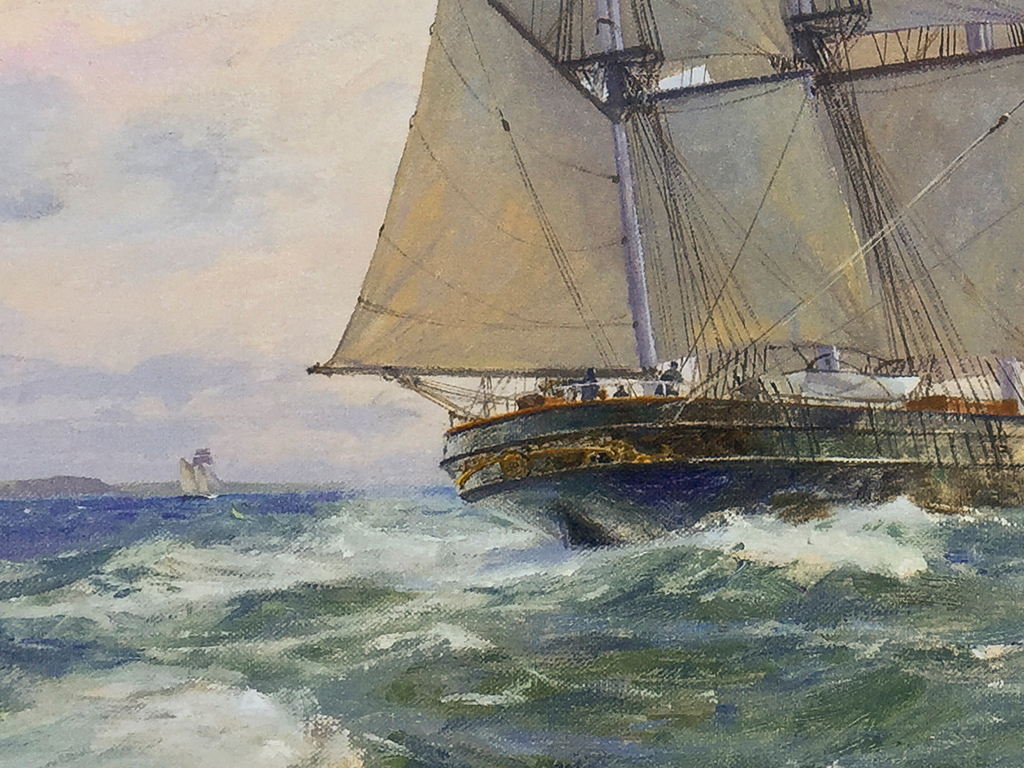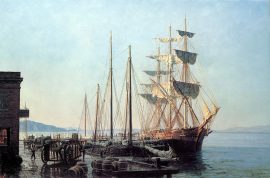Ariel & Taeping
$200.00
From Geoff Hunt’s Speed Under Sail Series. Rival tea clippers race up-Channel on 5th September 1866, 99 days after leaving Foochow together. They shared the premium for landing the first tea of the season.
LONDON, WEDNESDAY, SEPTEMBER 12, 1866.
The great ocean race of the five out of the nine sailing ships, from China to England, ended in the closest run ever recorded, and is an event of unprecedented occurrence. A sailing match over a distance exceeding 14,000 miles, or nearly twice the diameter of the globe, is a severe test to try the qualities of a ship, and to bring out her perfection or faults in hull or rig. The close arrival of the whole fleet that sailed first proves that all the ships were well handled, and that the fullest advantage was taken of every breeze, no tack being executed but either ship out of place. That they carried on a full spread of canvas we may readily suppose, though it is not every vessel that sails best when under a full press of sail. The ships were the Taeping, of Glasgow, 767 tons register, Captain M’Kinnon, owned by Messers. Rogers and Co.; the Ariel, of London, 852 tons register, Captain Keay, owned by Messrs. Phillips, Shaw, and Lowther; the Serica, of Greenock, 702 tons register, Captain Innes; and the Taitsing, 815 tons register, Captain Nutsford, Both owned by Messrs. Findlay; and the Fiery Cross, of Liverpool, 689 tons register, Captain Robinson, belonging to Messrs. Campbell. The first two to arrive were the Taeping and the Ariel, which entered the Downs on the morning of the 6th inst., followed by the Serica the same day, at 1 in the afternoon. The Fiery Cross made her appearance the next morning; and the Taitsing arrived off Portland at 8 a.m. on the 9th. There was thus only three days’ difference in the arrival of the first and last of the five ships. The Taeping and Fiery Cross discharged in the London Docks, the Ariel in the East India Docks, the Serica in the West India Docks, and the Taitsing in the same dock as the Serica.
What it interests Navigators to know are the courses steered by the respective Masters. These the reports furnished by the Captains do not supply. All we learn from Captain Innes’s report is, that he crossed the Line in the Serica on the sixty-eighth days out, and that from thence to the Cape de Verds he had westerly winds. From those islands he fell in with a strong N.E. trade to 27 N., on the 18th of August. Captain Robinson, of the Fiery Cross, passed Mauritius in lat. 22 41 S., long. 58 W. This is on the outer circle of the Roderiquez hurricane track, but in outside the Roderiquez track, bearing away to the southward from the Straits of Sunda till about 80 lat., and then they haul round to the westward, and pass the Cape in about 38 S. lat. The Fiery Cross fell in with the Taeping on the 7th of Aug., three days after crossing the Line, and parted company with her again on the 29th, in lat. 41 5 N., long. 35 51 W. The Taeping and Fiery Cross therefore separated on the north-west of the Azores. Some Shipmasters shape their course from Cape Verds to Madeira, but others make to the westward. When the Taeping bore away she was hull down in four hours. This was where the Fiery Cross was evidently beaten. Captain M’Kinnon altered his course before the other ship, or he was fortunate in catching a slant of wind. The Taitsing crossed the Equator on the 12th of August, having sailed from Foochoofoo on the 1st of June. The Ariel crossed the Line on the 5th. The Serica, Ariel, and Taeping left together on the 30th of May, and the Fiery Cross on the previous day, the 29th. The Fiery Cross gained on the first 3,000 miles of the voyage very considerably on her competitors, for she got through the Straits of Sunda on the 19th of June, the next batch being the Ariel, Taitsing, and Serica. Looking, therefore, at the difference in tonnage of the vessels, it may be said that they are of nearly equal sailing qualities, if they are all navigated with the same ability. We see in a yacht race in the Channel that one vessel will head the squadron when beating against the wind, but when running free falls back and loses ground. This must be the case with sea-going ships. Some sail faster and beat to windward better than other vessels. Again, a vessel that can crack on when close hauled, from being stiff, in a strong breeze, is weathered in light winds and smooth sea by a more tender ship. A run, however, of fourteen thousand miles must give opportunities for forming average results, and for making calculations as to lines, trim, position of masts, and exact canvas for propulsion under varying conditions of wind. There is one other point necessary to be observed, and that is – the quantity of cargo to register tonnage of each vessel. This may be understood by the following. The Taeping took in 1,108,700 lbs. of tea, the Ariel 1,230,900 lbs., the Serica 954,236 lbs., the Fiery Cross 854,236 lbs., and the Taitsing 1,093,130 lbs. Messrs. Steele, of Greenock, built the Taeping (composite), Ariel (composite), and Serica (iron), and the last held her way well with the wooden hull ships. If the Masters would give the actual distance run by log we could form an idea of the average speed each day and hour for the whole voyage. The Taeping was first in dock, and gained the purse. The other four ships – the Ada, Black Prince, Chinaman, and Flying Spur, – sailed on the 3d, 5th, and 6th of June, and their passage will show whether they have fallen in with the same fortunate winds. The Shipping and Mercantile Gazette, Wednesday, September 12, 1866.












